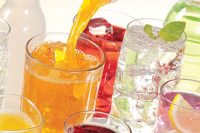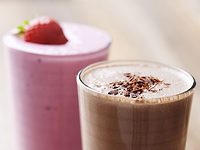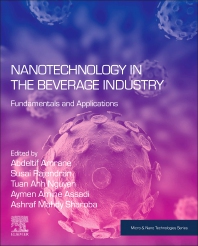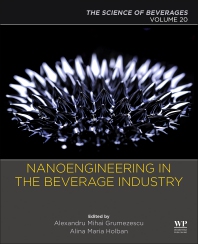Hydrocolloids help simplify beverage complexities
Hydrocolloids add stability to complex beverage formulations

Similar to how gamers try to navigate through the complex and intricate challenges of some of today’s latest video games, research and development (R&D)

|
specialists for the beverage marketplace are navigating through their own sets of challenges as they develop more complex formulations. And, once again, similar to how programmers will slip in codes to help gamers bypass some of their toughest challenges, beverage manufacturers have found that stabilizing agents can transform a complex formulation into a functioning beverage.
“The use of hydrocolloids has become very popular in the beverage market as formulators have been coming up with more complex systems that require stabilization,” says Daniel Bailey, an R&D scientist with Gum Technology Corp., Tucson, Ariz. “We have recently seen a lot of acidified dairy beverages, ready-to-drink (RTD) cocktails, and different types of protein beverages emerge on the market. Most of these types of applications contain proteins in the presence of acids or alcohol, requiring the use of hydrocolloids to achieve emulsion stability and protein protection.”
In addition to dairy-alternative beverages and protein-based drinks, John Crump and Michael Flemmens of TIC Gums, White Marsh, Md., say the growth of RTD coffee and tea beverages has impacted the hydrocolloid market. “...New tea product introductions in 2012 included the addition of many new flavors and functional ingredients,” they say. “The role of hydrocolloids in RTD tea is to enhance the texture and stability [of the beverage]. As more beverages and beverage-makers emerge, pressure to differentiate their offerings for other similar products will grow.”
Another area in the beverage marketplace that formulators are accounting for is sugar reduction or the use of more complex sweetener systems.
“I think probably the biggest trend we see impacting the use of hydrocolloids in beverages today is the trend for reduced calories and reduced sugar in all types of beverages — both carbonated and still beverages,” says Sean Allen, texturing solutions sales manager with Cargill, Minneapolis. “The key is reducing those caloric factors while still maintaining a great-tasting beverage. Hydrocolloids are necessary to help build back the mouthfeel in those beverages, so we certainly see that sugar reduction or calorie reduction is a huge trend affecting this industry.”
The use of hydrocolloids will help create that balance the sugar properties provided, notes Wen Shieh, texturizing solution technical leader for Cargill. “When we remove sugar from the formulations, they always leave a gap for the mouthfeel, so in order to get a great-tasting beverage, usually we will try to balance the sweetness and mouthfeel.”
TIC Gums’ Crump and Flemmens note that manipulating texture with gums in reduced-sugar formulations will present opportunities for bottlers and brewers to market and sell healthier beverage options that more closely resemble full-sugar varieties in appearance and texture.
Although these more complex formulations have their place in the beverage marketplace, consumer demands also are opening the door for clean and simplified labels, experts note.
“Beverage consumers are interested in what goes into their drink,” says Dinah Diaz, market development manager with Ingredion Inc., Westchester, Ill. “A perfect example is the recent consumer push for the removal of [brominated vegetable oil] (BVO) from beverages. By understanding market and consumer needs, we are able to provide manufacturers with turnkey solutions. In fact, we have [had] the ability to formulate weighting agents and BVO out of beverages for a number of years with Q-Naturale, a natural saponin from the quillaja saponaria tree.”
Q-Naturale operates as a high-efficiency emulsifier to provide stability as an alternative to weighting agents like BVO, Diaz explains.
Opportunities and options abound
Whether for complex beverage formulations or simplified solutions, these overarching trends have shown promise for the hydrocolloid market.
Noting the increases in the hydrocolloid market, Gum Technology's Bailey says that initially gelatin and xanthan gum were popular hydrocolloid choices for formulators due to their specific properties, like gelatin’s creation of strong gels and xanthan gum’s ability to increase viscosity and emulsion stability. However, as new formulations are developed, the demand for hydrocolloids has evolved to require unique properties and functionalities to specific products, he explains.
For example, pectin is an ideal hydrocolloid to help recover mouthfeel for beverages that have decreased or eliminated sugar, explains Jane Schulenburg, global marketing director for CP Kelco, Atlanta.
“As you remove sugar, [beverages] get watery, but … if you’re removing it from fruit juice, for example, you’re removing it for both cost and for health reasons,” she says. “You can use just a little bit of pectin and recover those drinking qualities, so that’s an excellent fit for that.”
Carboxymethyl cellulose (CMC), on the other hand, is useful when beverage-makers are looking for a range of viscosities, such as light and refreshing or thick and indulgent, Schulenburg explains. CMC also can be used as a direct replacement for guar gum, she adds. However, if manufacturers desire a hydrocolloid for good suspension without developing viscosity, she recommends gellan gum.
“If you want to keep a light, refreshing mouthfeel with good shelf stability and suspension, you can’t beat the performance of gellan gum,” Schulenburg says. “It’s one of the best ones on the market, and gellan gum can be used in neutral protein drinks [and] soy milk-based systems — it has a fantastic fit in soy-based milk. You also can use these in energy drinks; you can use gellan gum everywhere.”
Although the opportunities for hydrocolloids are on the upswing, formulating applications that meet growing demands remains critical, Ingredion’s Diaz says.
“The needs of the beverage manufacturer continue to evolve as they try to meet the ever-changing needs of consumers,” she says. “The ability to continuously innovate in this area and provide solutions to the industry is critical and something Ingredion continuously addresses through innovative solutions such as our Dial-In Sweetness and Texture solutions or new ingredients like Purity Gum Ultra emulsifier or Q-Naturale high-efficiency emulsifier that offer cost savings; unique functionality [for clear beverages]; natural, clean label claims; and more.”
Even though hydrocolloids can play a crucial role in the food and beverage markets, ingredient suppliers are keeping tabs on the other influencing factors and how volatile the market can become if not closely monitored.
“I think over the past few years, we’ve seen a number of events that have impacted the supply side of the hydrocolloid marketplace,” Cargill’s Allen says. “Everything from export restrictions out of countries, transportation cost changes, [and] weather has been a critical factor impacting hydrocolloids in that many of the raw materials used to make hydrocolloids have been impacted by frost events, droughts as well as other natural disasters such as the earthquake in Asia.”
He adds that applications in non-food industries including pharmaceutical, personal care and oil drilling have influenced the market.
Some hydrocolloids that have been impacted are guar gum and xanthan gum, experts note. “Guar gum, a general all-purpose thickener, has jumped to historic high pricing due to a dramatic increase in use by the oil and gas industries for fracking use,” says Joshua Brooks, vice president of sales and marketing and general manager for Gum Technology Corp. “Guar moved from around $0.89 [a pound] to $11 [a pound] within a year. Guar has now dropped in price to around $3.50 [a pound], which is more tolerable yet still well off the lows before. Xanthan, due to anti-dumping litigation brought against the Chinese and a Western supplier, jumped considerably as well.”
However, because of the functional properties and low-use requirements to achieve that functionality, hydrocolloids still can be a cost-effective solution, experts note.
“The use level of these products are less than 2 percent of the finished beverage — in some cases down to 0.5 or 0.25 percent of a beverage — but they have a significant impact either on the shelf life or the consumer drinking qualities,” CP Kelco’s Schulenburg says.
Looking for a reprint of this article?
From high-res PDFs to custom plaques, order your copy today!










